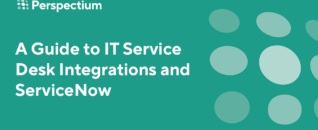How to Make Your Integrations Thrive
In his post Top 5 Reasons That Integrations Fail, David Loo, Perspectium CEO, expressed that at times, integrations fail because of employee turnover, IT system changes, unreliable connections, new security and privacy rules, or unrealized business value.
In the same post, David also suggested solutions—ways to anticipate and solve each of those problems. The bottom line was that your integration can survive if you partner with an integration provider that knows these issues and expertly addresses them.
Beyond surviving, your integrations can also thrive. Once you have partnered with an integration provider, you can take some simple steps to get even more from the integration solution. Here are five ways to make your integrations thrive.
1. Articulate the Business Benefits
Customers often sign on with an integration provider because doing so is a no-brainer. Companies determine it to be absolutely essential to connect systems for visibility, performance, data quality, new revenue streams, and many other business benefits.
The daunting prospect of creating and maintaining in-house integrations makes the build-vs-buy decision obvious. You’re not in the integration business, so you rely on an integration provider, letting you focus on your mission.
But as companies move forward after they sign up for an integration provider, they find that analyzing and expressing those business benefits in more detail prompts ideas for refining and expanding their integrations. Of course, in the face of budget pressure, articulated business benefits protect their integrations as well.
As you seek to articulate the business benefits of your existing integrations, consider these questions:
- What are the business problems that we face without integrations?
- How does the particular integration solution you selected address those problems?
- How has the solution helped? What problems have decreased and what benefits have increased?
The clear expression of benefits gives you firm footing for drawing more value from your integrations.
2. Articulate the ROI of Your Integrations
As you analyze the business problem and integration benefits in more detail, you are more likely to quantify the return on investment. To help you do so, consider some of these questions:
- Performance: What are the company-wide cost savings of preserving the performance of your ITSM production instance?
- Reporting: What are the business benefits of increased visibility as a result of better reporting?
- Service continuity: Without the integrations, would certain services discontinue? What is the hourly cost of failing to deliver those services?
- New services: What is the additional revenue as a result of new services that integrations enable?
- Reduced maintenance: How many hours of ongoing in-house integration maintenance are you saving per year? We estimate that custom-built integrations have an annual cost of 25% of the initial cost to build the integration.
- More ideas: See our TCO calculator for another tool that helps you articulate ROI.
Analyzing and expressing the ROI of your integrations helps you demonstrate the value of your IT initiatives to stakeholders.
3. Maintain Communication with Your Integration Provider
Staying connected with your provider presents new ways to enhance business value.
Customer Success
A complete integration solution will include the services of a customer success manager. This contact person is your advocate at the provider and a source of support for you.
To check that you are getting maximum benefit from your integrations, stay in touch with that customer success department. They will check the pulse of your integration with you, ensuring that you’re satisfied.
They’ll also conduct periodic service reviews to identify ways that you can enhance the value that you draw from your solution.
Provider News
A constantly evolving integration provider offers new developments to augment the integration possibilities for your company.
- Ensure that you are on the email list.
- Attend online events such as provider webinars.
- Follow the provider’s blog, and connect on social media.
4. Learn New Use Cases
A major advantage of using a provider’s solution over a custom-built solution is that the provider has seen (and implemented) a host of integration use cases. The provider has worked with customers to ensure that the integrations succeed for a variety of challenges that the diverse customers have.
Take advantage of that knowledge.
- Online stories: Read the provider’s public case studies to learn about how else you might be able to make use of the integration framework.
- Conversations: Inform the success manager or another contact at the provider about your own business challenges, and probe whether there might be a solution available through that provider.
- Webinars: Watch recorded customer webinars, and stay alert to new customer webinars.
- Product releases: Keep an eye out for new releases with functionality that enables you to meet more needs and gain new business value.
5. Engage in Customer Community
When you sign up for an IT solution, you also often get the benefit of access to a network of customers who are in your shoes.
Online Customer Community
Connect with customers through the provider’s customer portal or forum where you can interact with other customers—learning stories, asking questions, offering your own stories and advice, and growing your professional network.
Company Events
Meet with your provider and their customers in person at user events. All of benefits you gain from online interaction with other customers are multiplied when you interact in person, which makes the learning and exchange of stories so much easier.
Maximize Integration Value to Grow Your Business
A solid integration provider offers end-to-end service. But you can gain even more value for your business through following some of these simple steps. When your integrations thrive, you enhance business value for your company—and, in the process, you give solid evidence that your IT endeavors are critical to the success of your company.









